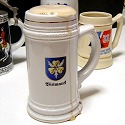
Report of the Commander in Chief, Navy, to the Führer on 10 April 1940 at noon.
1. The Commander in Chief, Navy refers to the views on operation "Weserübung" expressed by him in recent conferences.
He had said that passage to Norway would with some degree of luck be successful, provided the element of surprise were maintained; the break-through and landing would probably also be successful if a determined thrust were made through the fortification zones, even though a certain stiffening in the attitude of the Norwegians was observed in the last few days; the return passage would be the most difficult part of the operation, and would call for all-out cooperation by the whole German Navy.
The first two parts of the operation, the approach and the penetration and landing, were carried out on the whole successfully as anticipated.
The losses (BLÜCHER and KARLSRUHE) are quite in proportion to the risks run and can definitely not be considered high.
The third part of the operation is in progress and will probably entail further losses.
2. The situation was made more difficult than anticipated by the fact that the British were also just conducting an operation involving mine laying on 8 April, to be followed by occupation of Norwegian bases.
This was confirmed by the presence of transports with the British Home Fleet, which were sighted on the afternoon of 9 April in the northern North Sea by attacking aircraft.
Numerous British and French naval forces were thus at sea in the northern North Sea as far north as the Lofoten Islands.
3. Details:
a. Battleships: Yesterday morning there was an engagement with heavy British forces in the Lofoten Islands area.
The REPULSE and another battleship were probably involved.
Further details are not known.
In the evening the Fleet Commander reported: Only 25 knots; two heavy turrets out of action.
Further inquiries have not yet been answered.
Losses by the enemy are probable.
Radio telegraph communication with the Lofoten Islands is very uncertain.
Plan: Both battleships are to force their way into home waters as soon as possible.
In case a battleship is put out of action or is not ready for action, the question arises whether to send the damaged battleship to Narvik for protection against further attacks, which are sure to come.
Putting into Narvik means that the ship is eliminated from future operations.
She will also be in great danger from aircraft carriers, without the compensation of any promise of effective operation.
Enemy battleships: Their situation and position this morning was not yet known.
The aircraft carrier FURIOUS put out of Scapa Flow yesterday evening, apparently to join the Commander in Chief, Home Fleet.
Note: According to later reports, three British and two German destroyers were sunk; several German destroyers have partially been
paralyzed and are serving as barrage batteries.
b. Situation in Narvik: According to a garbled radio message (not in code) received at 0604 today, destroyers were attacked this morning in Narvik by enemy forces, probably destroyers and several cruisers.
The situation is not clear.
At 0830 one destroyer reported a severe destroyer engagement off Narvik.
The situation must be regarded as serious, since the troops on land are without artillery.
The most urgent matters are the defense of Narvik and the question of supplies.
No supply vessels have arrived as yet.
It is requested that reinforcements and materiel be sent immediately on Swedish railways via northern Sweden.
It is planned to increase the number of submarines in. order to take effective measures against British operations.
c. Situation in Trondheim: The situation regarding the coastal batteries is still obscure; according to information from the OKW, fortifications are safe in German hands and the airfield is out of service.
The vessels of the supply group have not arrived, and it is uncertain whether they will arrive.
Increased submarine protection is also planned here.
Cruiser HIPPER and two, later three, destroyers are scheduled to put out this evening, carrying only a small amount of fuel.
They are to refuel at sea, but it is questionable whether this can be accomplished.
d. Situation in Bergen: The cruiser KÖNIGSBERG (damaged), the BREMSE (damaged), the CARL PETERS, and the S-boat flotilla remain in the harbor.
A ship arrived with mines.
Three batteries are partially ready for firing this evening.
The Commanding Admiral, Scouting Forces, plans to put out this evening with the KÖLN and torpedo boats.
The situation in Bergen appears to be assured.
This base is very exposed to air attacks, however.
e. Situation in Christiansand: The TSINGTAU and the S-boat flotilla remain in the harbor.
The KARLSRUHE was torpedoed yesterday while putting out and was later sunk.
The crew was taken aboard torpedo boats.
f. Situation in Oslo: The LÜTZOW and the EMDEN have not yet put in because the mine situation is not yet clarified.
The BLÜCHER sank yesterday after hitting a mine.
It is planned to withdraw the LÜTZOW this evening.
g. Urgent missions: Reinforcement of the Skagerrak mine field.
Submarine chase is to be carried on in the Kattegat and the Skagerrak with all available means.
Sea transports must be escorted.
Supplies to western ports cannot be shipped by sea.
At the beginning and at the conclusion of the conference, the Führer expressed his full appreciation to the Commander in Chief, Navy for the great achievement of the Navy.
|
 BOOK: The Battleship Bismarck. The Complete History of the Ship.
 Naval & military gifts
|
